2014 - 2017 Azalea Evaluation Program
Azaleas are one of the largest single crops grown by nursery
producers in the southeast, generating over $4 million USD in sales
in Georgia and 39.5 million USD in sales across six southeastern
states
Census of Agriculture, 2007. Being the largest flowering
woody ornamental crop group grown in the southeast, maximizing
flowering potential and plant production is extremely important to
the profitability of commercial growers. New plant introduction and
integration into production systems continues to be a challenge for
growers due to the sometimes overwhelming number of cultivars
available on the market. The requirements of the market compound
these challenges due to the short sales window that is often
influenced by spring weather/climate. In recent years, the market
for azaleas has been transformed with the introduction of a plethora
of new cultivars, bringing a new interest in this specialty crop.
There are now 66 cultivars of re-blooming azaleas available along
with over 100 commonly available traditional spring only blooming
cultivars. This increase in cultivars and the challenges of the
marketplace have created a need for better information. Due to the
nature of the nursery industry, producing and publishing information
based on their own observations, reliable standardized information
of cultivar characteristics is not available. This study was
designed to address three primary needs; (1) to develop information
needed for producers and consumers/end users to be able to evaluate
and choose the best cultivar(s) to meet their needs, (2) to identify
pest-resistant cultivars that will thrive in landscape environments,
and (3) to find ways to manipulate the bloom period of azaleas in
order to speed or delay flowering to coincide with the desired
market window.
The objective of the project was to allow CANR to address the
aforementioned needs. The first of these needs, to develop the
information needed for growers, retailers, landscape contractors,
and consumers/end users to be able to evaluate and chose the best
azalea cultivars to meet their needs, was approached using several
techniques. CANR secured and trialed 150 cultivars of azaleas at
CANR, representing re-blooming azaleas and the most common
commercially available traditional spring-only flowering azaleas.
These cultivars were evaluated for timing of flower, flower size,
and color under the same environmental conditions, to develop a true
comparison of flowering period. Longer term growth habit and cold
hardiness for each cultivar was researched from external
authoritative sources. This information will allow professionals and
consumers to make informed choices on which cultivar(s) fits their
needs. The project also provided for the evaluation and
identification of cultivars with lower levels of azalea lace bug and
strawberry root weevil damage, therefore requiring less intensive
pest management and therefore a greater profitability for the
producer and more environmentally friendly option for the consumer.
The project allowed CANR to consolidate this information into easy
to understand publications that are available in a digital format
free for download and use from the CANR website. Additionally,
posters have been printed and will be distributed at meetings of the
Green Industry for use by professionals to increase the visibility
of this information to the consumer.
The last objective of the project was to determine methods to
manipulate the bloom period of azaleas in order to speed or delay
flowering to coincide with the desired market window (thereby
increasing demand and profitability to producers). In order to
accomplish this goal, CANR ran a series of trials to look at
dormancy and chemical plant growth regulator (PGR) manipulation of
flower timing. CANR performed a replicated study looking at the
interaction of temperature in the root zone and air temperature and
their effect on plant growth and flowering. The information from
this study has allowed a better understanding of what environmental
factors cause plant growth and flowering. Additionally, CANR ran a
series of trials using available PGRs to determine their effect on
flowering and growth in an outdoor setting in order to determine the
potential to use PGR treatments to modify the timing of flowering.
PGR trials were not successful in manipulating peak bloom period for
a specific sales window. There was still valuable information gained
form this project, including a better understanding of dormancy in
azaleas and the interaction of available PGRs on dormancy in
azaleas. The information learned via this project will also help in
developing potential methods for bloom period modification in other
crops in the future. Dr. Chappell (University of Georgia,
Horticulture Department) is currently working on the publication of
the results from the temperature modification trial in horticultural
journals, and a discussion of results from both trials can also be
found here the CANR website.
Few intereesting items from the data:
Largest flower size:
George L. Taber
Mrs. G.G. Gerbing
Tama No Hada
Formosa Purple
Higasa
Least Amount of Damage from of Azalea Lace Bug:
Red Slipper
BNA Lavender Twist
Mother's Day
Girard's Hot Shot
Amy
Girard's Crimson
Bollywood
Snow
Deja Bloom Pink Ribbons
Encore Autumn Fire
Least Amount of Damage from Strawberry Root
Worm:
Chinzan
Flame Creeper
Momo No Haru
Gumpo Pink
The Robe
Azalea Trial Bloom Photos Poster PDF
Azalea Cultivar Data Summary Poster PDF
Azalea Bloom Time Environmental Responce PDF
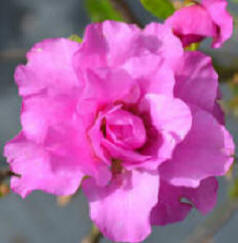
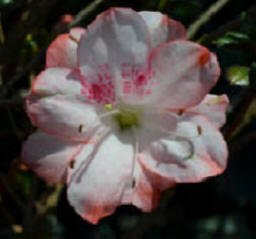
Azalea Plant Growth Regulator Bloom Time Modification Discussion PDF
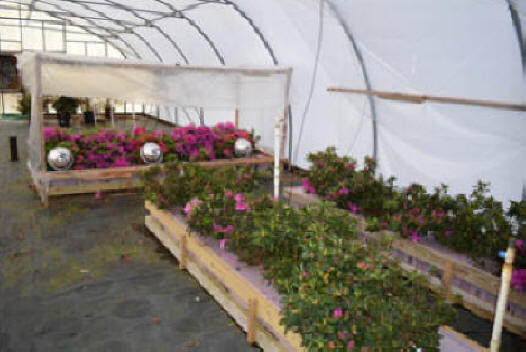
For more information on this project please fee free to contact us email at director@canr.org.
Funding for this publication was made possible by the U.S. Department of Agriculture’s (USDA) Agricultural Marketing Service and the Georgia Department of Agriculture (GDA) through a Specialty Crop Block Grant. Its contents are solely the responsibility of the authors and do not necessarily represent the official views of the USDA or GDA.
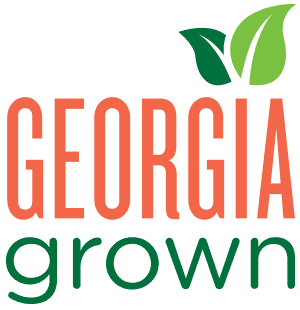














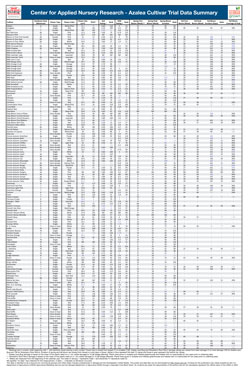
.jpg)